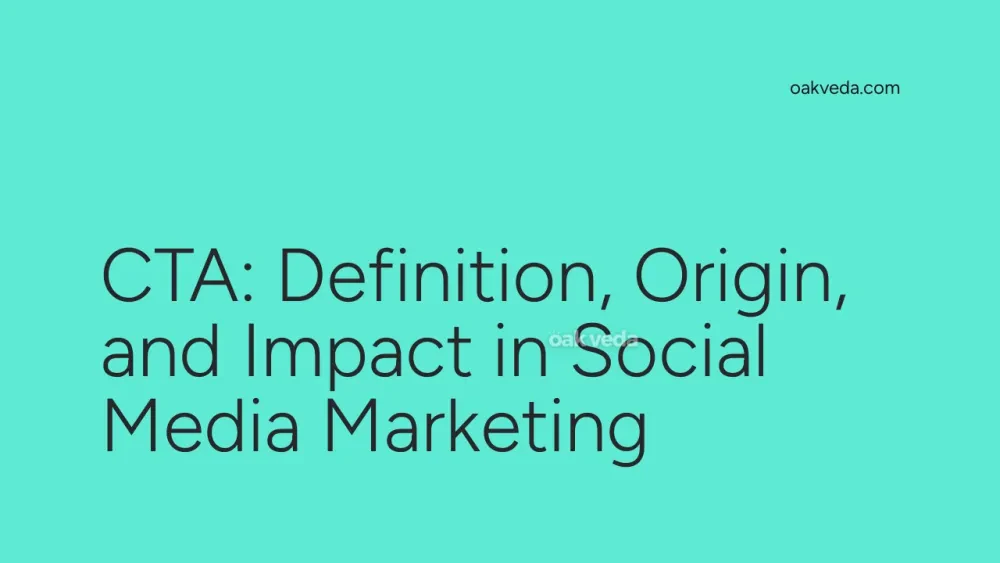
What is a CTA?
A CTA, or Call to Action, is a crucial element in social media marketing that prompts users to take a specific action. In the context of social platforms, a CTA is typically a short, compelling phrase or button designed to encourage immediate user response. These prompts can range from "Sign Up Now" to "Learn More" or "Shop the Collection," serving as a bridge between content consumption and desired user behavior.
Origin and Development of CTAs in Social Media
While CTAs have long been a staple in traditional marketing, their role in social media has evolved significantly. As social platforms transformed from mere communication tools to powerful marketing channels, the need for effective CTAs became paramount. The development of CTAs in social media can be traced alongside the growth of social commerce and paid advertising features on platforms like Facebook, Instagram, and Twitter.
How CTAs Work in Social Media
CTAs in social media function by creating a sense of urgency or value proposition that motivates users to act. They work by:
- Capturing attention with concise, action-oriented language
- Clearly communicating the benefit of taking action
- Reducing friction in the user journey from interest to action
- Leveraging psychological triggers like FOMO (Fear of Missing Out) or exclusivity
Effective CTAs are strategically placed within posts, stories, bios, and ads to maximize visibility and impact.
Types of CTAs in Social Media
Different types of CTAs serve various marketing objectives:
- Lead Generation CTAs: "Sign Up for Our Newsletter," "Download Our Free Guide"
- Engagement CTAs: "Like if You Agree," "Share Your Thoughts in the Comments"
- Sales CTAs: "Shop Now," "Get 20% Off Today"
- Brand Awareness CTAs: "Learn More About Us," "Watch Our Story"
- Event CTAs: "Register for Our Webinar," "RSVP to Our Launch Party"
Popular Examples of CTAs in Social Media
Some widely used and effective CTAs include:
- Instagram's "Swipe Up" feature in Stories
- Facebook's "Shop Now" button on product posts
- Twitter's "Follow" button for increasing audience
- LinkedIn's "Connect" CTA for networking
- Pinterest's "Save" button for content curation
Impact of CTAs on Social Media Culture
CTAs have significantly influenced social media behavior and expectations. They've:
- Accelerated the transition from passive scrolling to active engagement
- Normalized direct response actions within social environments
- Contributed to the rise of social commerce and in-platform purchasing
- Shaped user expectations for clear, actionable content
Controversies Surrounding CTAs in Social Media
While CTAs are powerful tools, they're not without controversy:
- Overuse: Excessive CTAs can lead to user fatigue and diminished effectiveness
- Privacy Concerns: Some CTAs collect user data, raising questions about data usage and consent
- Authenticity Issues: Overly aggressive CTAs can feel inauthentic, potentially damaging brand trust
How Brands and Influencers Use CTAs
Brands and influencers leverage CTAs to:
- Drive traffic to websites or landing pages
- Increase follower counts and engagement rates
- Boost sales and conversions
- Gather user-generated content
- Build email lists and nurture leads
Successful strategies often involve A/B testing different CTA variations to optimize performance.
Future Trends Related to CTAs in Social Media
The future of CTAs in social media is likely to involve:
- Increased Personalization: AI-driven CTAs tailored to individual user preferences and behaviors
- Interactive CTAs: Augmented reality (AR) and voice-activated calls to action
- Seamless Integration: CTAs that feel more native to the platform and less disruptive to the user experience
- Data-Driven Optimization: Advanced analytics to refine CTA performance in real-time
- Ethical Considerations: Greater emphasis on transparent and consent-based CTAs
FAQs about CTAs in Social Media
What makes a CTA effective on social media?
An effective social media CTA is clear, concise, and creates a sense of urgency or value. It should be visually prominent and aligned with the user's interests and the content's context.
How often should I use CTAs in my social media posts?
While there's no one-size-fits-all answer, it's generally best to use CTAs strategically rather than in every post. Aim for a balance that maintains engagement without overwhelming your audience.
Can CTAs work on all social media platforms?
Yes, but the format and approach may vary. Each platform has its unique features and user expectations, so tailor your CTAs accordingly.
How do I measure the success of my CTAs?
Track metrics such as click-through rates, conversion rates, and engagement levels. Many social media platforms offer built-in analytics tools to help you assess CTA performance.
Are there any legal considerations when using CTAs?
Yes, especially when collecting user data or making promotional offers. Ensure your CTAs comply with platform policies and relevant regulations like GDPR or CAN-SPAM.
In conclusion, CTAs are a powerful tool in the social media marketer's arsenal. When used effectively, they can significantly boost engagement, drive conversions, and help achieve various marketing objectives. As social media continues to evolve, so too will the strategies for creating and implementing effective CTAs. By staying informed about best practices and emerging trends, marketers can ensure their CTAs remain impactful and relevant in the ever-changing social media landscape.
You may be interested in:
- Content Calendar: Definition, Origin, and Impact on Social Media
- SRP (Social Relationship Platform): Definition, Origin, and Impact
- Main Character Energy: Definition, Origin, and Impact
- CTR (Click-Through Rate): Definition, Origin, and Impact
- Affiliate Marketing: Definition, Origin, and Impact
- Content Creator: Definition, Origin, and Impact

